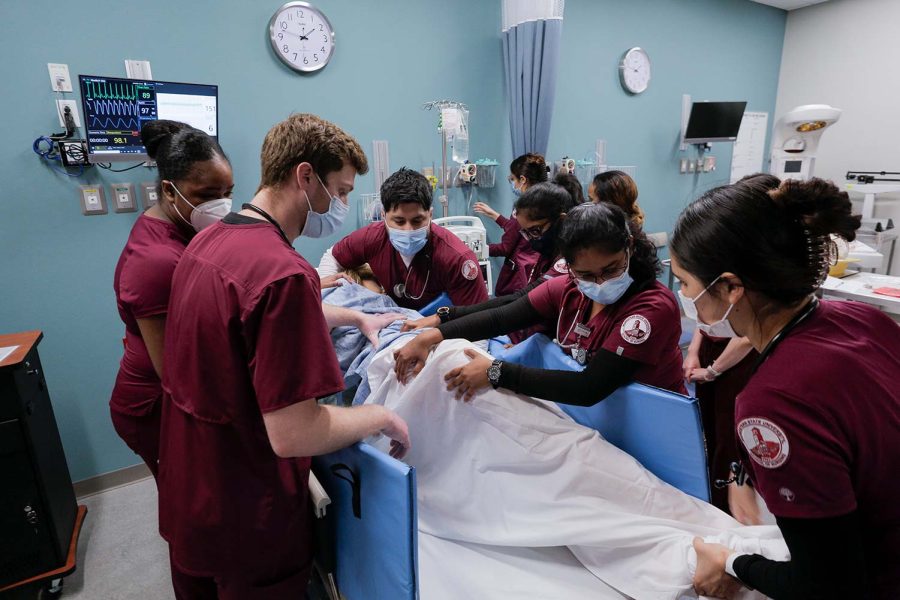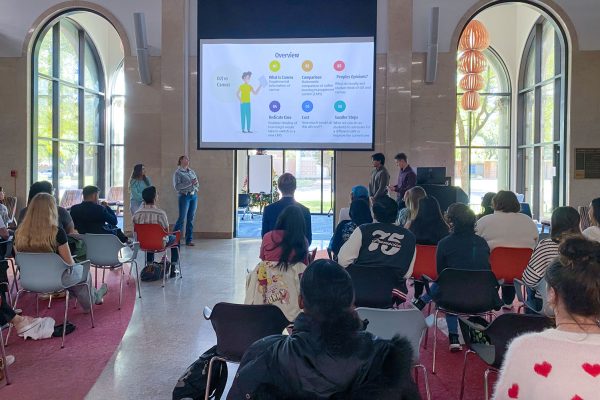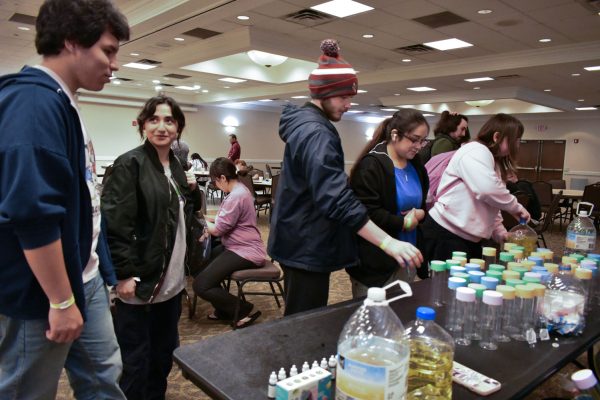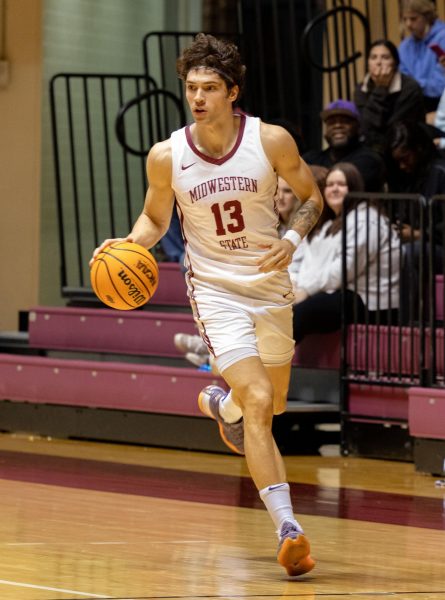Nursing students face challenge in entering medical field during pandemic
Nursing students turn a pregnant simulation dummy onto her side to counteract the onset of a seizure, Mar. 10.
As mask mandates and COVID-19-related restrictions lift across much of the country, the pandemic remains as a source of both planning and concern for the nursing school. Since being disrupted alongside the rest of the university in spring of 2020, faculty and staff in the nursing school have worked hard to ensure students learn both the basics of nursing and how to navigate a new, pandemic-dominated medical field. In spite of the challenges the last two years have brought to nursing education, nursing seniors Ashley Alcala and Luz Garcia say they feel prepared to enter the workforce in the COVID-19 era.
Garcia said the help she received from professors is one reason for her confidence.
“For me I would say definitely yes, prepared. Especially with some of the professors, they stick out a little bit more. It’s like a one-to-one relationship, and they say ‘hey, do you need help with something?’ you know, especially during the semesters before becoming a senior,” Garcia said.
As seniors, Garcia and Alcala are closest among students to graduating and entering the workforce. They also felt the hardest effects from the lockdown in spring of 2020 which forced classes online and temporarily suspended nursing clinicals. Seniors are the only nursing students whose clinical slate was affected, as all subsequent classes have been able to participate in a full load of clinicals.
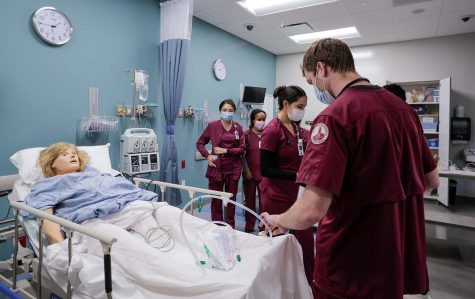
Alcala said she would have liked more in-person experience and face-to-face interaction with patients.
“I feel like we didn’t get a lot of clinical and bedside skills since we were cut short from our clinicals,” Alcala said.
Garcia echoed Alcala’s concerns.
“I think having more face-to-face clinical experiences, even during the COVID pandemic, would have helped those students who graduated without that clinical experience. I know it was hard for them to work it out though. So, probably just having more clinical experience rather than just having more class time, or convert that class time into more clinical experience,” Garcia said
Despite her concerns about clinical time, Alcala said she feels prepared by her professors to work as a nurse in the COVID-19 era.
“I feel like they have, used different tools to prepare us. I feel confident in my skills that they have prepared us,” Alcala said. “…they did the best that they could in the COVID era.”
Robin Lockhart, chair of nursing programs, said concerns from outside the program that nursing students won’t be prepared due to missed in-person time are unfounded.
“I see a lot on the social media, people afraid that these graduates will be trained or taught without doing any direct patient care. We were out of direct patient care half a semester. Because spring 2020 we had finished half of our direct patient care and we went into lockdown. Summer, we don’t have clinical courses for our pre-licensure program. We do in our accelerated program, but they were put in remote hospitals that would allow them in that summer. So they didn’t go into isolation from the clinical area. And then after spring, then the next for our regular program was fall, we already had them back in the hospitals for that fall. So it was only half a semester that they didn’t have direct patient access,” Lockhart said.
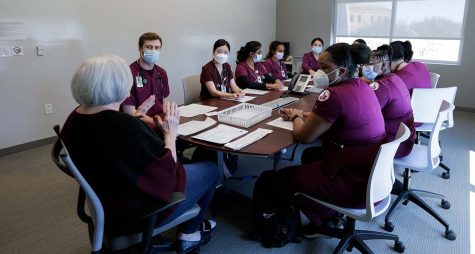
Lockhart added that educators in the nursing program worked to make up for the lost time and material over the duration of the students’ time in the program.
“And we took those groups and what they missed in that half a semester and we just added it to the remaining of the program. A little here, a little there, and so we picked back up,” Lockhart said.
Even as seniors who were affected most by the missed time, Alcala and Garcia pointed to other areas that helped alleviate the gap in their experience.
“Yeah, so we have a lot of modules that we’re being given as homework, you know, to practice our decision-making skills since we don’t have a lot of bedside opportunity. So I think that those modules have prepared us to make those critical decisions and be able to think and not having that in-person interaction, patient face-to-face I guess,” Alcala said.
Garcia added that nursing students are taught how to properly use personal protective equipment in addition to getting hands-on experience dealing with COVID cases.
“Also, they have taught us how to do proper PPE. Because our clinicals, since we do our clinicals at United Regional, we do take care of COVID patients already, even if like, we’re students. So we have the order of putting it, the order of taking it off,” Garcia said.
Lockhart said teaching students to use PPE was a point of emphasis.
“In that spring of 2020 when COVID really first hit and we were having to make adjustments, one of the things that we did was spend a lot of time working on the personal protective garments, and getting that equipment on and off safely. We put a lot of focus on that, and we did a lot more focus about the whole isolation and respiratory issues of COVID,” Lockhart said.
Lockhart also said they’ve incorporated COVID cases into classroom simulations. Simulations involve dummies that are assigned conditions and symptoms by instructors, then ‘treated’ by students.
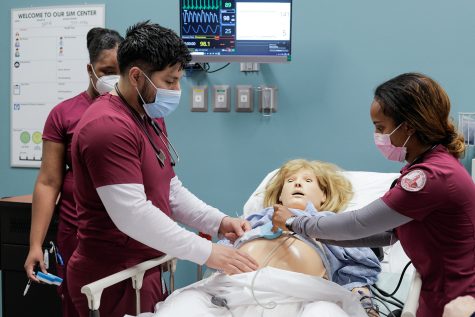
“And then, as time has gone on, it’s been more about protecting themselves, preventing further spread. We do add COVID cases to our simulations and to our classroom cases that we present. Or we may have cases that we’re presenting in class that are something else, but we may also give them COVID, the patients COVID, so that they experience all of the concepts that are associated with that,” Lockhart said.
Lockhart expressed confidence that nursing students will be ready for the unique challenges of the pandemic.
“I feel very good that these students are well-prepared for this,” Lockhart said.

Hello, and thanks for stopping by! My name is Cecil Witherspoon, and I'm the new editor-in-chief of the Wichitan. I'm a mass communication senior with...

Howdy hey! I'm back for my final year here at MSU, and I intend to leave the Wichitan better than I found it.
Going into my fourth year, I will be working...



